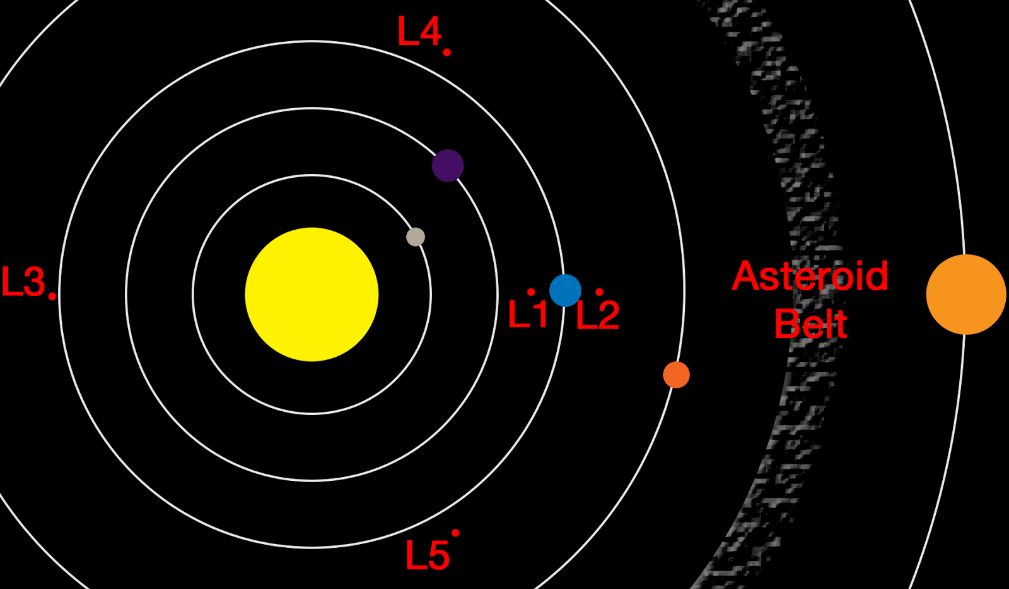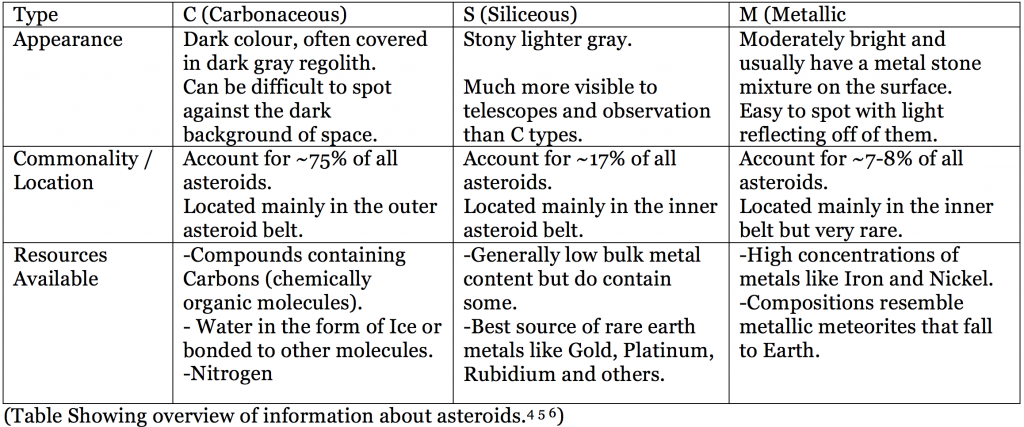Asteroid Mining
By Riley Whyte, Matt Kozun, Brett Blatz
The mining of asteroids is not a new concept. Since the modern age of spaceflight, there have been many theories, thoughts, and experiments on how to accomplish resource collection from these astronomical bodies. In today’s world, as technology advances, it seems that the prospect of this happening grows closer and closer to reality. Asteroid mining and resource collection from asteroids is theoretically a sound idea with many opportunities for useful exploitation of resources; practically, however, technology has a long way to go before any worthwhile large resource extraction occurs.
If all the technology required has not been developed and tested how can it be known that asteroid mining is a viable process? It comes down to a few things, firstly it is already known which asteroids are suitable candidates for resource exploitation. By understanding what materials are available on the varying types, scientists can pick ones that would be most worthwhile to visit. As well, there are many practical uses for the minable resources, such as fuel and electricity, that would be extremely beneficial to spaceflight. As stated prior, the biggest hurdle inhibiting the advancement in this area of space exploration at the moment is that of technology and cost; however, if that hurdle can be conquered then the benefits of asteroid mining would be incredibly valuable to the progress of spaceflight in our solar system.
Overview of Research
- What Asteroids are Suitable Candidates
- What Resources are Available
- Methods of Collection
- Possible Uses and Practicality
- Where are we now in the Development of the Technology
- What Would an Asteroid Mission Look Like
- Conclusion
What Asteroids are Suitable Candidates
The suitability of an asteroid for resource harvesting can be narrowed down to two main variables: its accessibility and its resource makeup. Accessibility is determined by the asteroid’s location relative to earth and how much energy would need to be expended to reach it. The vast majority of asteroids in our Solar System are located in the asteroid belt which exists between the orbits of Mars and Jupiter.1 The massive gravitational influence of Jupiter has essentially corralled these loose objects into similar orbits of the sun. The remainder of objects exist on random trajectories or smaller groups throughout the solar system and are scattered in much lower densities, none of them orbit the Earth.
The closest thing that we have to an Earth orbiting asteroid is a relatively new finding called a “Trojan Asteroid”. These Trojan asteroids may exist at one of the Lagrange points where gravitational forces between the Sun and the Earth balance out and hold objects like asteroids in place. In theory, the right trajectory would allow a spacecraft going as far as Lagrange point 4 (L4) to expend the same or less energy as it would to get to the Moon.2
At the moment, the only Earth Trojan asteroid confirmed to exist is 2010-TK7 and it resides at the L4 point.2 This is a relatively new area of study as 2010-TK7 was just discovered in 2010, and as of March 1st 2017 the Osiris-Rex spacecraft has begun searching the area on its fly-by to try and discover more.3
What Resources are Available on these Objects?
While it is possible to travel to these asteroids it is important to know what kinds of resources certain objects have in order to make the trip worth it. As a brief overview, there are 3 general categories of asteroids; Type C, Type S, and Type M. Each contain resources but they do not all contain the same kind or abundance of resources.
Asteroid Overview
It is important to go a little more in depth into the presence of these resources to help determine their usefulness.
Carbon
Carbon is found in many organic forms especially on C-Type objects.7 (Side note: Organic does not mean life necessarily, an organic compound in chemistry is one that contains mainly atoms like Carbon, Oxygen and Hydrogen) We know this from studying meteorites that have landed on earth and determining their composition.8
Water
Water is not found in the form of liquid ponds on the surface but rather as ice or in the chemical makeup of other compounds. Water or H2O contains Hydrogen and Oxygen both of which are also very useful resources. The presence of water on an asteroid was first confirmed in 2010 9 with later subsequent discoveries on other asteroids.10 This suggests that water is much more common on these and other celestial bodies than was first hypothesised.
Heavy Metals
Asteroids in general, contain an abundance of metals and have a much higher concentration of them than Earth’s crust does. Industrial metals like Iron, Nickel, and cobalt are relatively easy to locate and make use of. While other more specialised metals like Ruthenium, iridium, platinum, gold and others can also be found. These “Rare Earth Metals” are rare on Earth and, while still sparse, in space they are more common and give us another source to draw from. 11
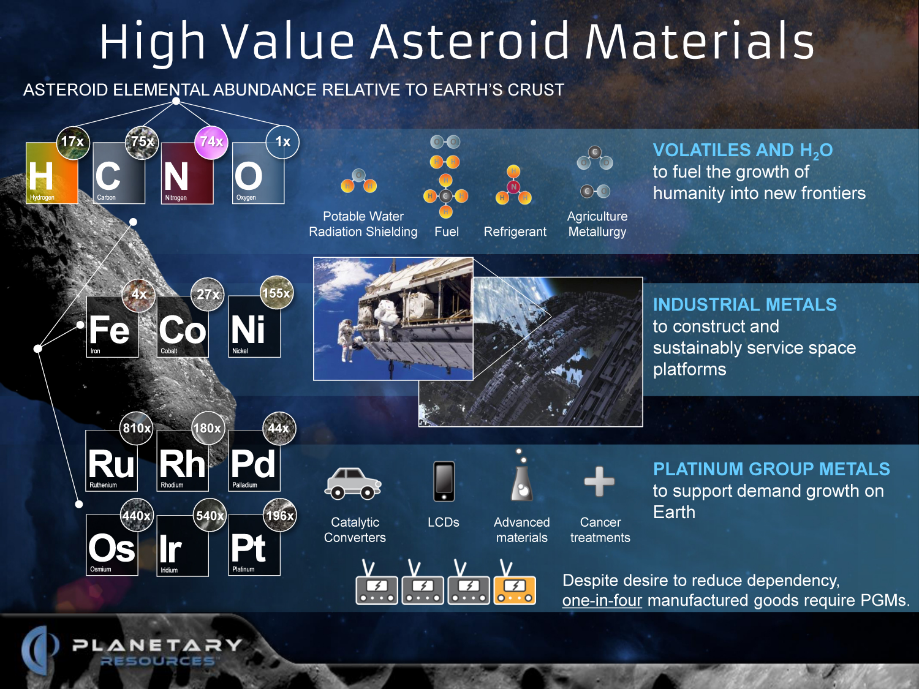
Figure 3: Graphic showing resources and some possible uses, Planetary Resources
Methods of Resource Collection
We know that we can get to the asteroids and we know what kind of resources we can expect to find when we get there. The next step is to obtain the resources from the asteroid through mining. Mining in one form or another has existed on Earth for thousands of years and over that time the techniques used have been refined to make them as efficient as possible.12 That said the unique environment of space offers a whole new set of challenge that would need to be overcome for certain techniques to work.
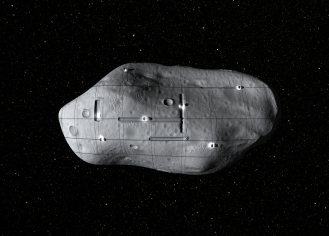
Figure 4: Rendering of What Strip mining of an asteroid may look like, Planetary Resources
Strip Mining
This technique involves scraping away layers of the object one at a time in a defined area. On Earth, it is used to excavate ore that is close to the surface and make it easily accessible by scraping away the layers of dirt covering it.14 This method is very useful when it comes to the collection of large amounts of material. In zero-g however this process may run into issues with a lot of material escaping by floating away as the excavation area is exposed to open space. Often explosives like TNT are used on earth to loosen up rock for excavation. In space however explosives are generally not a good idea, (High velocity debris with no gravity or physical barrier to slow it down) so a relatively soft asteroid that requires no blasting would be ideal for this method.
Tunneling
This technique is used on Earth for large volume collection of resources deep below the surface and is what is often thought of as traditional mining.15 At the moment this is the most likely option as it allows for a closed environment which can be a great advantage for dealing with zero-g. It gives you places to mount drills and other heavy equipment as well as making the collection of loose material easier as it is trapped in the tunnel. Theoretically, due to the physical barrier of the tunnel and with a hard enough asteroid and careful planning, blasting with explosives could be performed in this environment.
Melting

Figure 5: Melting Process shown in graphic, Planetary Resources
This technique is not used on Earth in the same way as it would be in space making it a unique process. This method would involve encapsulating a smaller asteroid that contains resources with relatively low melting temperatures, (I.e.: Water-Ice) and slowly raising the temperature using energy from the Sun. Once the water has melted and boiled off the vapour can be collected and re-condensed for use. This would likely leave some material behind but it is a quick and low effort option when compared to some of the others previously discussed.16
The variety of possible techniques available for different situations shows that the physical mining of asteroids is possible with enough planning and technology. Aside from the challenges presented by operating in zero gravity another problem to conquer with the required equipment is weight. On Earth, many of these machines are extremely heavy 17 which can be a problem if you are launching them into space on a rocket that can only lift so much. If the weight can be shaved down on this equipment, like it has on other equipment adapted for space, then it is reasonable to think it may be a feasible solution. Once we can get the equipment to the asteroid it is a process of trial and error to determine what methods work.
Possible Uses and Processing of Material
It is possible to get to the asteroids, know what resources to collect, and to go through the physical process of collecting them. Now comes the most important part, making use of the resources. Through some creative chemistry there is a wide variety of uses for some of the simpler materials like hydrogen, oxygen, and carbon. Industrial metals can also serve their purpose in space without having to be transported all the way back to Earth. Let's go a little more in depth on some of the uses of these materials:
Hydrogen
The simplest element on the periodic table, Hydrogen extracted from water and other compounds have a wide variety of uses in space including fuel, electricity, and water. Cryogenic liquid hydrogen has been used as a rocket propellant since as early as 1956.18 Due to its low weight and high combustion rate it makes an excellent choice for rocket engines both in space and in the atmosphere. It is currently used in combination with liquid oxygen on many rockets including the Atlas 5 and Delta IV19 and will likely continue to be used far into the future. Hydrogen can be also used as a monopropellant in the form of Hydrogen Peroxide for reaction control systems on spacecraft.
For electricity and water one can take advantage of the technology of fuel cells which use a chemical reaction over a charged catalyst to create electricity. In the case of Hydrogen, a fuel cell uses its reaction with Oxygen over a charged catalyst of Platinum to create electricity, with the by-products of water and heat.20 This technology is extremely useful as it gives two important resources for a spacecraft and was used onboard the Space Shuttle.
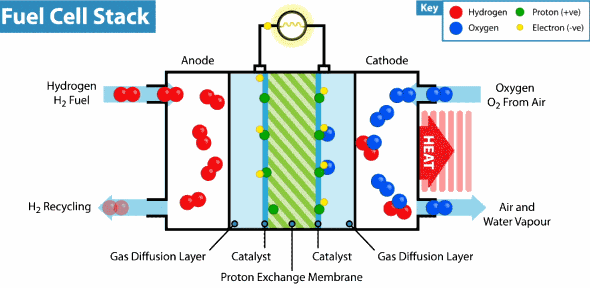
Figure 6: Animated GIF showing the operation of a Fuel Cell, Geek.com
Oxygen
Oxygen can be used for fuel, electricity, water, and breathable air; all of which are extremely valuable and essential for long-term human spaceflight. In much the same way as hydrogen, liquid oxygen can be used as a rocket propellant in the form of a fuel or an oxidizer as it is extremely combustible. This liquid oxygen, or LOX, has been used in many liquid fuel spacecraft including the space shuttle, Saturn V, Falcon 9, and the Soyuz.21, 22
As was also stated in the section on hydrogen, oxygen can be used in a fuel cell to produce electricity and water for the vessel. While these are both extremely important there is one more role that only oxygen can fulfil when it comes to human spaceflight, that role is breathable air in the form of O2. There are carbon scrubbers that can remove CO2 from the air on spacecraft 23 but having a backup supply/source and excess of oxygen is never a bad idea in the harsh vacuum of space.
Metals
There are two things that come to mind when one thinks of the usefulness of mined metals; using them as building materials or selling them. For heavy low-cost metals like iron and nickel shipping them back to Earth does not make financial sense, but using them for construction in space does. In a more advanced setup, metal refining and shaping could be theoretically used to build structures in space. 3D printing of metal is a suggestion that is currently being studied as it would allow for the raw metal resource to be used very efficiently.24 These strong metals could be used or 3D printed in a smaller scale to manufacture needed replacement parts and tools making them invaluable to an isolated spacecraft.

Figure 7: Image shows laser metal deposition method of 3D Printing, Frabricatingandmetalworking.com
While selling the metals for good money may sound tempting at first it is important to consider the scale of the operation to retrieve them. Metals like gold and platinum do fetch a high price but when you spend millions of dollars on the equipment to retrieve them and take them back to Earth your profits can be extremely diminished. Before this venture would become profitable compared to mining ventures on Earth you would need a strong established asteroid mining industry and infrastructure to help cut costs. This does not mean it is not feasible, it would just likely not be very profitable at first like many mining ventures are.
Practicality
It is apparent from the previous examples that practicality really depends on what resource you are looking for. In the case of Hydrogen and Oxygen mining, it is very practical as it would give you essentially a gas station in space where you could stock up on fuel, water and air before venturing farther out into the solar system. Other resources like bulk industrial metals and rare earth metals require a little more thought behind their practicality. While they could also be utilized they are not as immediately useful as other materials and require a more established asteroid mining industry before their true usefulness can be realized.
At the moment space programs around the world are looking towards asteroids as a major source of scientific information. As a result, many missions have been launched to study asteroids recently, including the Osiris-Rex 3 and NASA Dawn 25 missions as well as the new planned Psyche and Lucy probes 1 announced earlier this year.
These probes show that rendezvous with an object and identifying the resources on it is possible. The next steps require newer technology that has been talked about previously. Fuel cells are an example of a technology that we already know a lot about and have continuously used successfully in space aboard the Space shuttle for the duration of its lifespan.20 These would allow the utilization of hydrogen and oxygen and could be put to use immediately.
Technology that still has some ways to go includes the mining equipment, heavy lifter rockets for getting it there, and the tools to perform some resource conversions on site. Mining equipment development is being undertaken by companies like Planetary Resources who are working on weight saving measures and new techniques for resource collection. Heavy lift rockets are also well under development with SpaceX’s Falcon 9, NASA’s SLS(Block 1 + 2), Ariannespace’s Arianne 6, and ULA’s DeltaIV Heavy with the new ACES upper stage.28 When these rockets are completed companies will have access to space for cheaper than ever before and also with weight capabilities not seen since the Apollo program’s Saturn V moon rocket.28 SpaceX and other companies are also looking towards the concept of ISRU (in-situ resource use) for future space exploration. SpaceX specifically is planning to collect methane on mars and use it to fuel its rockets for the return trip home.29

Figure 8: Graphic showing possible launch vehicles, Kerbal Space Program Forum
What Would an Asteroid Mission Look Like
Conclusion
Asteroid mining and resource collection from asteroids is a sound idea with many opportunities for useful exploitation of resources; practically however technology has many hurdles to overcome before it sees mainstream use. Current missions have demonstrated that travelling to and rendezvousing with asteroids is possible. They have also shown us just what these bodies are made up of which gives us the ability to prospect the asteroids and determine viable targets for resource collection. While mining techniques for space still need to be developed there are companies that are looking towards this future and determining that it is not an insurmountable task. Scientifically the use of these resources is a sound process and would give human’s new capability for travelling the solar system. Perhaps what is most promising is how all of it is coming together, while asteroid mining may have been a thing of fiction for many years we are rapidly approaching a point where it will become reality.
References
1 Universe Today, What is the Asteroid belt? (http://www.universetoday.com/32856/asteroid-belt/)
2 Wikipedia, Earth Trojan Asteroids (https://en.wikipedia.org/wiki/Earth_trojan)
3 NASA, O-Rex Mission Webpage (http://www.asteroidmission.org/)
4 Philip Metzger, What kind of Asteroid to Mine (http://www.philipmetzger.com/blog/type-of-asteroid-to-mine-part-3/) (2013)
5 NASA, NEAR Press Kit (http://nssdc.gsfc.nasa.gov/planetary/text/asteroids.txt)
6 S. Shaw, Asteroid Mining (http://www.astronomysource.com/tag/s-type-asteroids/) (2012)
7 Wikipedia, Carbonaceous Chondrite (https://en.wikipedia.org/wiki/Carbonaceous_chondrite)
8 Wikipedia, C-type Asteroid (https://en.wikipedia.org/wiki/C-type_asteroid)
9 C. Moskowitz, Water Ice Discovered on Asteriods for the First Time (http://www.space.com/8305-water-ice-discovered-asteroid-time.html)
10 M. Wall, Water Ice Common on Asteroids, Discovery Suggests (http://www.space.com/9292-water-ice-common-asteroids-discovery-suggests.html)
11 N. Atkinson, What are Asteroids Made of (http://www.universetoday.com/37425/what-are-asteroids-made-of/)
12 General Kinematics, A Brief History of Mining (https://www.generalkinematics.com/blog/a-brief-history-of-mining-and-the-advancement-of-mining-technology/)
13 Wikipedia, Drilling Rig (https://en.wikipedia.org/wiki/Drilling_rig)
14 Wikipedia, Surface Mining (https://en.wikipedia.org/wiki/Surface_mining)
15 TechnoMine, Tunneling (http://technology.infomine.com/reviews/tunneling/welcome.asp?view=full)
16 Shane D. Ross, Near-Earth Asteroid Mining, Space Industry Report (2001) (http://citeseerx.ist.psu.edu/viewdoc/download?doi=10.1.1.614.9343&rep=rep1&type=pdf)
17 CAT US, Product Information List (http://www.cat.com/en_US/products/new/equipment.html)
18 NASA, Liquid Hydrogen as a Propulsion Fuel (https://history.nasa.gov/SP-4404/ch8-1.htm)
19 NASA, Liquid Hydrogen - The Fuel of Choice for Space Exploration (https://www.nasa.gov/topics/technology/hydrogen/hydrogen_fuel_of_choice.html)
20 Smithsonian Institution, Fuel Cells (http://americanhistory.si.edu/fuelcells/basics.htm)
21 M. Brain, How Rocket Engines Work (http://science.howstuffworks.com/rocket5.htm)
22 Wikipedia, Liquid Rocket Propellant (https://en.wikipedia.org/wiki/Liquid_rocket_propellant)
23 NASA, Recycling Air and Water in Space, pg.2 (https://www.nasa.gov/pdf/146558main_RecyclingEDA(final)%204_10_06.pdf)
24 Q. Bean, 3D Printing in Zero G (https://www.nasa.gov/mission_pages/station/research/experiments/1115.html)
25 NASA JPL, Dawn Mission (http://dawn.jpl.nasa.gov/)
26 Wikipedia, Osiris-Rex (https://en.wikipedia.org/wiki/OSIRIS-REx)
27 NASA, Osiris-Rex Mission Objectives (https://www.nasa.gov/osiris-rex)
28 Wikipedia, Heavy Lift Launch Vehicles (https://en.wikipedia.org/wiki/Heavy-lift_launch_vehicle)
29 The New Atlantis, R.Zubin, Colonizing Mars: A Critique of the SpaceX ITS (http://www.thenewatlantis.com/publications/colonizing-mars)

